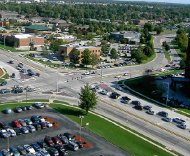3/26/2012
Academic Paper Justifies Signal Time Shortening in MissouriSpringfield, Missouri shortened yellows prior to the installation of red light cameras on advice of camera salesman.

A paper presented at the Institute of Transportation Engineers (ITE) annual meeting two years ago offered a justification for shortening the duration of yellow warning times at intersections prior to the installation of red light cameras. Until then, the relation between signal-time shortening and automated enforcement has been anecdotal. Springfield, Missouri's former traffic engineer, Earl E. Newman, provided a formal, twenty-page defense that revealed the idea ultimately came from a red light camera salesman.
Springfield set out to hire American Traffic Solutions (ATS) to run a red light camera program in 2006. As ATS began testing to find the most promising intersections to place cameras, the company noted that the yellow warning period was significantly longer at intersections maintained by the Missouri Department of Transportation (MoDOT) in comparison to city-owned locations, even though the city and state used the same ITE formula to set the signal time.
"To the vendor's credit, the vendor immediately advised staff to review the data because there was a remarkable difference between red light running at MoDOT intersections compared to city intersections," Newman wrote.
Springfield and ATS specifically targeted the fifteen highest volume intersections in the city for camera enforcement -- locations that averaged over 50,000 vehicles per day. Eleven of these busy spots were found on state-controlled roads. Testing in December 2006 found the four city locations averaged 13.1 violations per approach with a 3.9 second signal time, while the MoDOT signals with an average 1.1 seconds of longer yellow had 78 percent fewer violations -- 2.78 per approach.
"Eighteen of the twenty-three approaches to MoDOT signals had five or fewer violations in the testing before retiming," Newman wrote.
Springfield was not interested in applying the successful MoDOT timing to the problematic city intersections. Instead, the city turned to Richard Retting, who is now on the payroll of automated enforcement company Brekford Corporation, for advice.
"It would have been a simple solution for the city to simply lengthen all yellow intervals to match MoDOT," Newman wrote. "Advice was sought from Richard Retting, formerly of the Insurance Institute for Highway Safety (IIHS), an ITE member and recognized expert on red light running and applications with red light camera enforcement. Richard advised the city and MoDOT to use the ITE recommended equation and find agreement on the assumptions so the yellow times would be determined in a consistent manner for all signals within the city of Springfield."
That meant a net shortening of the yellows in Springfield. Before Retting's intervention, all but two of the MoDOT intersections had yellows of 5.0 seconds or longer up to a high of 6.0 seconds. After retiming, the eleven MoDOT locations were shortened dramatically. At Chestnut and Campbell, the timing tumbled from 5.0 seconds to 3.7 seconds. Kansas and Kearney dropped from 6.0 to 4.8 seconds. The four city locations increased a half-second from 3.9 to 4.4 seconds.
Although Newman portrayed the changes as successful on the basis of safety, his data show total crashes increased 6 percent at the signals with cameras. Red light camera violations did decrease with the longer yellow at city locations, but Newman only provides numbers for two of the eleven intersections with shortened yellows, making it impossible to quantify the full impact of the changes.
A copy of the ITE paper on yellow time shortening is available in a 600k PDF file at the source link below.


